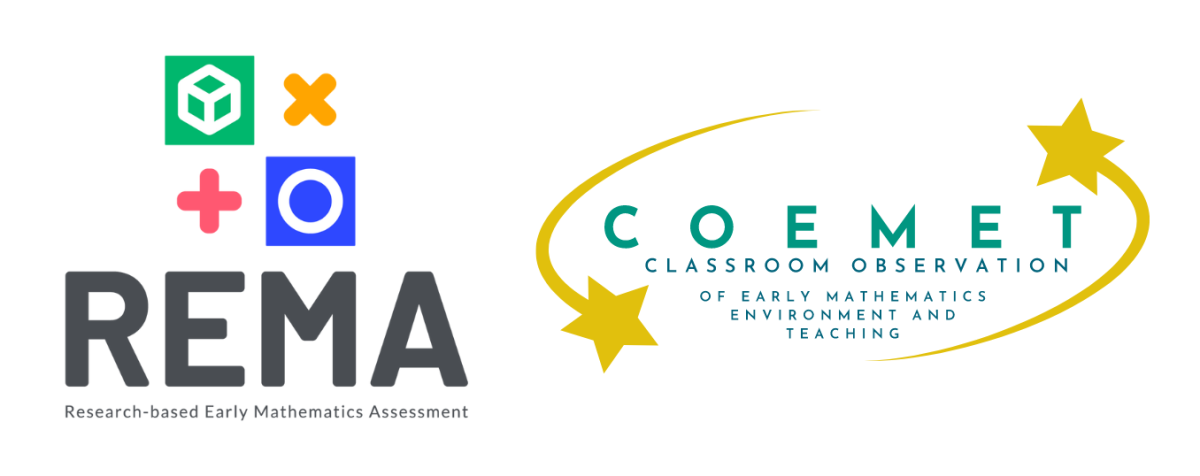Early Math Measures
Two resources for researchers that are highlighted below include a measure of children’s mathematical learning and a measure of classroom quality focused on early math. The Marsico Institute both uses and provides training for others to use these two instruments.
Research-based Early Math Assessment (REMA)
The REMA is a research-based math assessments based on the developmental progression of early math across multiple math topics. The measure emerged from over two decades of research and development. All versions of the REMA are diagnostic assessments measuring children’s mathematical knowledge and skills along research-based developmental progressions (National Research Council, 2007; Sarama, 2009). These developmental paths are closely related to national and state standards, thus the REMA can be useful in assessing progress where standards are a valued piece of the research.
The measure uses an individual interview format with explicit protocol, coding, and scoring procedures. Most versions of the assessment (except the REMA Brief) document students’ solutions, strategies, and error types. The REMA Brief is appropriate for children in pre-K only, while all other versions of the assessment are appropriate for children ages 3-8 years. The versions of the REMA are designed to be used by researchers, school psychologists, or teachers trained in assessment.
The REMA measures mathematical competence in several ways. The basic way is as a latent trait in Item Response Theory (IRT), yielding a score that locates students on a common ability scale with a consistent, justifiable metric (allowing accurate comparisons, even across ages and meaningful comparison of change scores, even when initial scores differ; Wright, 1979). The assessment items are ordered by Rasch item difficulty; students stop after three consecutive errors (with the exception of the REMA Brief). There are two parts (Parts A, number and operations; Part B, geometry, patterning, algebraic thinking, measurement, and other topics). Measures children’s correctness and strategy use on select items.
Other versions of the REMA
REMA Short Form: An abridged version of the REMA to be used when time is short. There are two parts (Parts A, number and operations; Part B, geometry, patterning, algebraic thinking, measurement, and other topics). Measures children’s correctness and strategy use on select items.
REMA Brief: An abridged version of the REMA for PK only; measures accuracy only.
REMA Learning Trajectories(LTs): These are topic, or Learning Trajectory-specific, subtests of the REMA to be used to have a full report on one topic. Measures children’s correctness and strategy use on select items, and is appropriate for multiple ages.
TEAM: This version is similar to the REMA, and is designed for teacher use for formative assessment and diagnosis.
Classroom Observation of Early Mathematics-Environment and Teaching (COEMET)
The COEMET was created based on a body of research on the characteristics and teaching strategies of effective teachers of early childhood mathematics (Clarke & Clarke, 2004; Clements & Conference Working Group, 2004; Fraivillig, Murphy, & Fuson, 1999; Galván Carlan, 2000; Galván Carlan & Copley, 2000; Horizon Research Inc., 2001; NAEYC, 1991; Teaching Strategies, 2001). Each item is connected to one or more of these studies. The COEMET takes into consideration the NCTM content standards (Sarama & Clements, 2007). It is divided into two sections: Classroom Culture (CC) and Specific Mathematics Activities (SMA). Each construct is assessed by considering various indicators; for instance, when determining a quality score for Eliciting Children’s Solution Methods, the observer considers the extent to which the teacher asked children to share, clarify, and/or justify their ideas; the teacher’s ability to facilitate children’s responding, as well as the teacher’s encouragement of children to listen and evaluate others’ thinking/ideas. Instructional quality scores for the COEMET are assigned on a 5-point Likert scale ranging from 1 = strongly disagree to 5 = strongly agree. An example of a Likert item shared by both instruments in the section Mathematical Focus, with response possibilities from strongly disagree to strongly agree, is "The teacher began by engaging and focusing children's mathematical thinking (i.e., directed children's attention to, or invited them to consider, a mathematical question, problem, or idea)."
